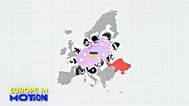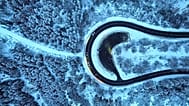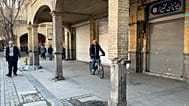What does climate mobility mean? Young Africans and Pacific Islanders share their thoughts from the frontlines at COP28.
Returning to Tuvalu between her studies in New Zealand “keeps me grounded” says Kalita Titi Homasi, “it refreshes my mind, refills my energy.”
There’s no place like home, but Titi’s Pacific island country is at risk of becoming uninhabitable by 2050 as sea levels rise. At 23-years-old, she has felt temperatures and droughts increase, seen beaches retreat and fishers forced further out - beyond the safe barrier of the reef - as coral bleaching makes fish scarcer.
We’re over 8,000 miles from her home now, speaking on the sidelines of the COP28 UN climate summit in Dubai. The conference failed to deliver the phaseout of fossil fuels which would have given low-lying island nations like Tuvalu a chance to retain and reclaim more land.
While letting polluters slip through its fingers with one hand, COP did create a new loss and damage fund with the other. This extends the scope of climate finance to promote “equitable, safe and dignified human mobility in the form of displacement, relocation and migration…”
Leaders of climate vulnerable countries have been wasting no time in making their contingency plans. For two very recent examples: the Marshall Islands has just completed a five-year project - remarkable in the breadth of its community involvement - to create a national adaptation or “survival plan”.
And Tuvalu has signed a deal with Australia to enable its people to move there. “I like to think of it as a bridge, to connect the opportunities that we Tuvaluans aren’t able to get,” says Titi, a biomedical science student at Victoria University of Wellington. “Australia is a bridge and even if people choose to go, I feel like they will always have the need to return.”
What does the Australia-Tuvalu agreement say about climate mobility?
The government won’t make people walk across this bridge - and couldn’t even if it tried. “If you ask anyone on the island, [the prospect of moving is] hard for them to understand. It’s hard for them to absorb, and it’s hard for you to explain to them. It’s just a whole different level of stubbornness,” she says, “the attachment is real.”
The Falepili Union - named after the Tuvaluan term for neighbours who choose to live in close houses - establishes a special visa arrangement for Tuvaluans to live, work and study in Australia. It also earmarks another AUD 16.9 million from Australia for its much smaller neighbour’s coastal adaptation efforts.
The deal has been criticised by some for the security advantages that Australia gets in return. Simon Kofe - Tuvalu’s former foreign minister whose video speech knee-deep in the sea caught the world’s attention in 2021 - has said it encroaches on Tuvalu's sovereignty and needs to be renegotiated.
“No agreement is perfect,” Kamal Amakrane, head of the UN-partnered Global Centre for Climate Mobility (GCCM) tells Euronews Green, “but it sets us on the right trajectory for where we should be.”
“There is no word of migration,” he explains. “There is no word of relocation. And there is no word of protection or asylum. It’s [about] climate mobility pathways, in dignity and sovereignty.”
Why is climate mobility so important?
Walking around the GCCM Pavilion at COP28, there’s little explicit mention of migration either. Enabling “people positive adaptation journeys” and “unprecedented adaptation journeys” read the two taglines on the wall.
The world has a long way to go to answer the gigantic questions raised by the latter, where countries are existentially challenged as a result of climate change. But the populist, global north narrative that mass migration will lead to societal collapse has been challenged by, firstly, robust research showing that the vast majority of movement will be internal.
And secondly, new narratives about what it means for the world to adapt to an inevitable level of cross-border migration - such as the compassionate, open-minded vision set out by science writer Gaia Vince in her book ‘Nomad Century’.
Speaking to young people at COP28, it is clear that they want to make their homes liveable for as long as possible.
“Climate mobility is not just about moving. [It] is about mobilising to adapt at the same time as holding on to our values, and what we hold dear to our hearts,” says Titi, who is from Nanumea and Niutao islands. “It’s about innovating, rethinking, recycling and adapting.”
So what do ‘people positive adaptation journeys’ look like?
As the GCCM and International Organisation for Migration (IOM) explored in numerous talks at COP28, the climate crisis may be global but adaptation is local.
Africa, the Pacific, Latin America and other regions all have their own narratives within this people-centred transition. But some common themes emerged.
Water issues are a core driver of climate migration
Harriette Okal, a 30-year-old Kenyan youth delegate with the GCCM, is currently studying for a PhD in hydrology at Rhodes University in South Africa.
“Mostly when we’re displacing people it’s either because of too much water, which is floods, or too little water, which is droughts,” she explains. Pastoralists in Kenya are used to erratic rainfall, but not able to factor forecasts into their movements.
With early warning systems, they would know whether to harvest water ahead of scarce times, or channel it away when heavy rainfall threatens. River monitoring networks, open data access and training are all part of this local adaptation picture, Harriette suggests, which would reduce displacement.
Neighbouring Somalia is also beset by swings from drought to floods, with the decades-long civil war making people “doubly displaced” says 23-year-old Ahmed. A severe drought killed the livestock in his village several years ago, causing a shortage of milk and meat and a subsequent breakdown of trade within the community.
Ahmed’s family had to move to the big city as a result, which isn’t an adaptation step everyone can afford, he points out. And even in the city there’s no escape from the crisis as people’s homes can be washed away.
Ahmed, who attended COP28 with Save the Children, says he would like to see investment in clean water, as well as smart, sustainable agriculture - areas where young people can lead on building resilience. Currently, he says, “people know nothing about the future - even the coming year if they face another drought or the rain coming - [they’re] just waiting for their fate.”
Youth can educate and help their people prepare
Climate mobility is about “changing scenarios,” Titi says. Seawalls being fortified with cement instead of sand. Or having Tuvaluan youth in spaces like COP28. “It’s really rare for Tuvalu or the Pacific,” she explains, “decisions are made by our ministers, our elders, but now they feel the need to involve young people because they know that we are the future leaders.”
While Tuvalu’s government communicates its predicament to the world, Titi sees a role for English-speaking, technology savvy young people to explain the situation to older generations.
Harriette’s advocacy also starts with climate literacy: “making the science into a local knowledge and transcribing it into a language that the local people can understand, [that] a child can understand.”
As Ahmed says of rural Somali communities in particular, people aren’t always aware of the fingerprints of climate change on ‘natural disasters’. “It’s sad because they don’t realise they are living in the middle of… It’s like a deathbed,” says Titi. “But they don’t realise that because we are very optimistic and resilient people and they love to think they can do this.”
Explaining the science is one thing - here, Titi thinks that visualisations of the data and different scenarios of sea level rise might help. But convincing people to consider moving is quite another.
In Tuvalu, families bury their dead just outside their houses. “Even like a few metres away, it’s hard for them to imagine relocating a thousand miles away.”
“There’s no way,” she repeats softly.
What can adaptation and loss and damage funding do?
“[We’re] very pleased with the outcome on loss and damage that includes recognition of the link between climate and mobility,” IOM Deputy Director General for Operations Ugochi Daniels said during one GCCM pavilion talk. “Though the devil is in the details.”
How will losses and damages be quantified exactly? And the funds dispersed - per capita, for example? Concerned parties like the IOM and GCCM are keen to see the right foundations built as these conversations continue.
And the youth delegates who journeyed to COP - while glad of the new fund in principle, and anxious to see it reach their especially vulnerable communities - remain focused on the other end of the climate process.
“The money is just coming to cover up for the fossil fuels that are still being used,” says Titi. “It doesn’t make sense.”
Harriette stresses the need for adaptation finance to build capacity before. “This loss and damage is literally [something] most of the countries are pledging as an afterthought,” she says. “Maybe it's because it's our nature to be like heroes. So we wait for disaster to happen.”





















